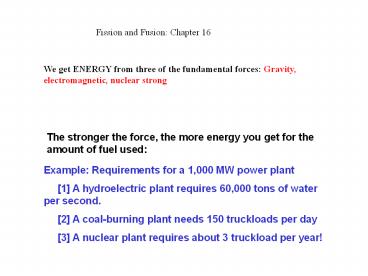Fission and Fusion: Chapter 16 PowerPoint PPT Presentation
1 / 25
Title: Fission and Fusion: Chapter 16
1
Fission and Fusion Chapter 16
We get ENERGY from three of the fundamental
forces Gravity, electromagnetic, nuclear strong
The stronger the force, the more energy you get
for the amount of fuel used
Example Requirements for a 1,000 MW power plant
1 A hydroelectric plant requires 60,000
tons of water per second. 2 A coal-burning
plant needs 150 truckloads per day 3 A
nuclear plant requires about 3 truckload per year!
2
Destructive power
1 Small towns have been leveled by floods and
landslides.
2 The same size town could be leveled by 1,000
tons of chemical explosives.
3 Hiroshima (quarter of a million people) was
destroyed by releasing the energy in 40 kg of
Uranium
We know the least about the strong nuclear force.
3
Fusion and Fission are governed by the nuclear
strong force.
Fusion two nuclei stick together (or fuse) to
form a new, larger nucleus
One new nucleus
Two separate nuclei
4
Fission When a single nucleus splits to form
two smaller nuclei.
Large nucleus
Two smaller nuclei
5
Suppose we pull the neutron and proton apart
Which situation above has more energy? Why?
You must do WORK on the nucleons in order to
separate themthus the separated ones have more
energy!
6
Now imagine putting a hydrogen nucleus together
instead of pulling it apart. We normally write
this in a special way
2
H
n p
1
neutron
Hydrogen nucleus
proton
n
p
This reads a neutron and a proton fuse together
to form a hydrogen nucleus.
7
2
H
n p
1
n
p
More energy
Less energy
Where did the excess energy from the
left-hand-side go?
There must be energy released in this process!!
It comes in the form of Radiant and Thermal energy
Nuclear (fusion) Energy
Thermal Radiant Energy
8
In the case of the fusion of a neutron and a
proton, were there any electrostatic forces
acting between them?
No, the neutron has no charge (its neutral).
Consider the case where two HYDROGEN nuclei fuse
together
9
Are there any electrostatic forces involved in
this nuclear fusion reaction?
Yes, each one has a proton.
What effect should this have on the two nuclei
before they fuse?
The two nuclei should repel one another.
10
Even though the nuclear force is much stronger
than the electromagnetic one, the RANGE of the
nuclear one is much smaller.
Range of nuclear force
nucleus
Range of Electromagnetic force
11
These dont get close enough to fuse together!
12
These get close enough to fuse together!
13
The result of the situation where they dont get
close enough is just a collisionthey bounce off
of one another.
The result of the situation where they DO get
close enough results in fusion a new nucleus and
a release of energy.
We can only get the nuclei close enough under
extreme heat and pressure. Eg., stars
14
STAR
Extremely High Temperature and pressure
Eheat Enucl
Eheat Eradiant
15
Eheat, in Enucl
Eheat, out Eradiant
If the heat output is GREATER than the heat
input, the reaction is self-sustaining
This is just like FIRE once you start a piece
of paper on fire it burns until there is no more
fuelsame goes for a thermonuclear reaction.
16
1.6727 x 10-27 kg
5.0066 x 10-27 kg
3.3437 x 10-27 kg
Why the difference? Where did the extra mass go??
1.6727 x 10-27 kg
3.3437 x 10-27 kg
5.0164 x 10-27kg
17
E mc2
Einstein has done it again! The mass was
converted into energy
The difference was 0.0098 x 10-27 kg
The energy released is then
E mc2
(0.0098 x 10-27 kg)(3 x 108 m/s)2
8.815 x 10-13 Joules
This is the measured energy release.
18
What is the difference between these two
situations?
The He fusion requires higher temperaturesthey
have to collide at higher speeds!
19
As we try to fuse together heavier and heavier
nuclei, the thermal energy required gets large
20
At some point, where the nuclei are so heavy (and
thus carry high positive charge) that the energy
required to sustain the reaction becomes larger
than the thermal energy output
If the heat output is GREATER than the required
heat input, the reaction is self-sustaining
The limiting atomic number is 26 (IRON) We can
create nuclei that are lower in atomic number
than iron and have a sustained fusion process.
21
The Nuclear Energy Curve
22
(No Transcript)
23
When a hydrogen bomb explodes, hydrogen fuses to
form helium. According to Einstein's mass-energy
equivalence that is, according to Emc2, does
this result in a change in the total mass of the
material? (a) Yes, the mass decreases, and by a
measurable amount. (b) Yes, the mass decreases,
but by such a small amount that it would be
impossible to measure it. (c) Yes, the mass
increases, and by a measurable amount. (d) Yes,
the mass increases, but by such a small amount
that it would be impossible to measure it. (e)
No, the mass remains exactly the same.
24
The fusion of 36Li and 510N results in creation
of (a) 816O and energy transformed to other
forms. (b) 24He and energy transformed to other
forms. (c) 816O and no energy transformed to
other forms. (d) 24He and no energy transformed
to other forms. (e) salami and cheese
sandwiches.
25
IN-CLASS PROBLEM Complete the following nuclear
fusion reactions

